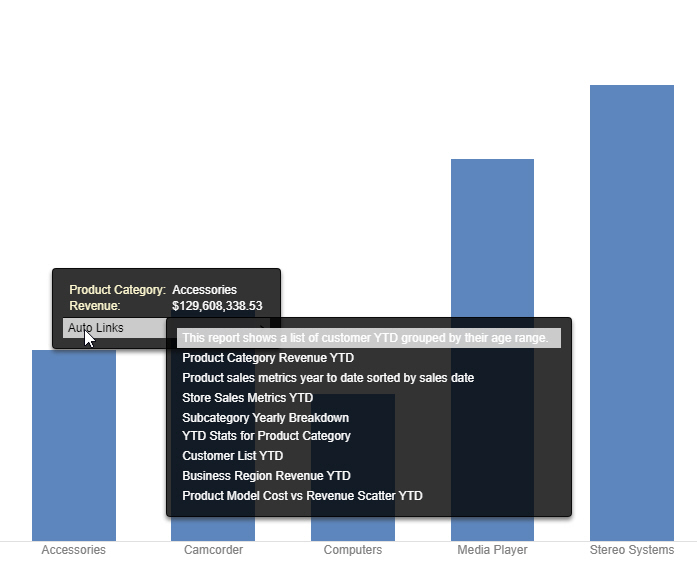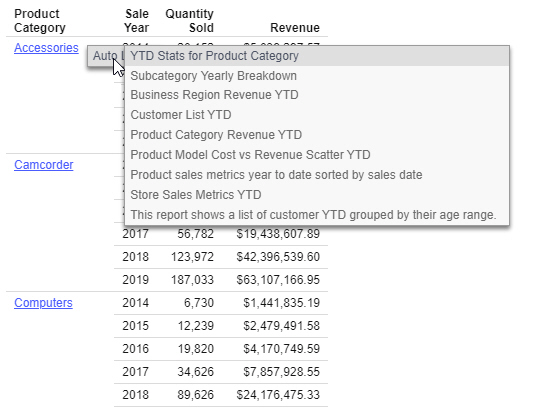Auto Linking makes it easy to connect reports and charts in your
development environment, expanding the reporting capabilities of
your organization. Using Auto Linking, you can dynamically link
multiple charts and reports with a single report or
chart of any format, based on their common sort (BY) fields and
parameters referenced in any filters. It is this commonality that
dynamically links content in your WebFOCUS repository, allowing
you to discover new possibilities in your data, and explore new relationships
within your reporting enterprise. In addition, Auto Linking saves
development time and effort, because drilldowns do not need to be
manually created and maintained.
To use Auto Linking, you must use the AutoLink option in WebFOCUS Designer to set the reports or charts that provide Auto
Linking drilldowns.
In addition, you must also set reports or charts to be Auto Link
targets. The options to enable and disable Auto Linking and Auto
Link target functionality are available in the Content area, located beneath the buckets on the WebFOCUS Designer Properties panel.
Auto Linking and Auto Linking target status can only be enabled for stand-alone content items. If you convert a chart or report
with Auto Linking to a page, a warning appears, alerting you that Auto Linking functionality will not be carried over.
Note: You can open an existing chart and enable Auto Linking
or set the item as an Auto Link target.
When Auto Link functionality is activated, tooltips in your charts
can display links in the tooltip for each sort (BY) field with qualifying target reports
or charts at run time. In Auto Link enabled
charts, you can add sort (BY) fields to the Vertical Axis, Horizontal
Axis, or Color field containers. In Auto Link enabled reports, Auto Linking drill-down links are added to each sort value
for which there are Auto Link targets available.
To qualify a chart as an Auto Link target, you must
include filters that contain the parameters that you selected as
the sort field or fields in Auto Linking enabled content. The parameter
names defined in these filters must be the same as the sort (BY)
field names in the Auto Link enabled chart. For example, if you Auto Linking enabled content uses Product Category as a sort
field, then the Auto Linking targets that are available will be those that have parameters for the Product Category field.
When you select a chart as the Auto Link target, it specifies that the parameter
information should be cataloged, and will be evaluated when an
Auto Link enabled chart is run.
For an Auto Link enabled chart or report at run time,
the target reports and charts are those that have filters with parameters
for all sort fields. For run time for charts, the
linked sort field values in the Auto Link enabled content is passed to the Auto Link target report or chart and used as a
filter value.
For example, you may have an Auto Link enabled chart that contains
sort (BY) fields, Product Category and Model, with a measure (Sum)
field, Revenue. To qualify as an Auto Link target, other charts in your repository can contain a single filter with a parameter
for Product Category, or two filters with parameters for both Product
Category and Model. When you run the Auto Link enabled chart, the
Product Category field will link to target reports or charts that
have a filter with a parameter for Product Category, and the Model
field will link to target reports or charts that have filters for
both Product Category and Model.
You can access the target reports or charts from a
tooltip option that displays when you point your mouse over an area
of the chart, such as a bar that represents Revenue by Product Category
and by Model.

